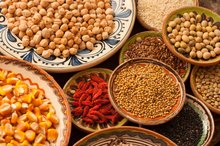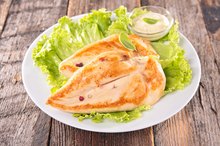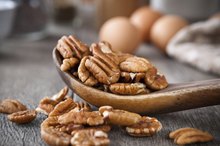Vitamins That Function As Coenzymes
Members of the vitamin B complex serve as coenzymes that assist every cell in the human body. They help the body metabolize carbohydrates, proteins and fats and build DNA for new cells. Without its coenzyme, an enzyme will not function. Vitamins work together in impressive ways as coenzymes or precursors to coenzymes. Precursors are substances that can be converted into active vitamins and coenzymes.
Thiamin
Thiamin, or vitamin B1, functions as a coenzyme in the oxidation of glucose. Thiamin serves as a coenzyme for several enzymes that take part in metabolic reactions. Eat meats, leafy green vegetables, whole grains and legumes to benefit from thiamin.
Biotin
3 Specific Uses of Enzymes in the Human Body
Learn More
Biotin works as a coenzyme for other enzymes that catalyze various chemical reactions in metabolism. For instance, biotin works with the enzyme pyruvate carboxylase, which is essential to the Kreb’s cycle, a complex series of chemical reactions that provides cells with energy. Biotin occurs in legumes, egg yolks, nuts and liver. Intestinal bacteria also synthesize biotin.
Cobalamin
Vitamin B12, referred to as cobalamin because it contains cobalt, serves as a coenzyme in many metabolic pathways. Vitamin B12 is synthesized by microbes and is obtained nearly exclusively from animal products.
Folic Acid
What Are the Benefits of Vitamin B-1 or Thiamine?
Learn More
Folic acid works as a coenzyme in synthesizing several amino acids, purines and thymine, which are used in making DNA. A deficiency of folic acid results in anemia and growth failure. Folic acid is found in many foods, including dark green vegetables such as spinach, beef, eggs and whole grains. It is also synthesized by intestinal bacteria.
Riboflavin
Riboflavin, also called vitamin B2, serves as a precursor to two important coenzymes, which in turn serve as carriers of hydrogen in many important oxidation reduction, or respiration, reactions within the mitochondria of cells. Riboflavin occurs in many foods, including milk, grains and meats.
Niacin
Niacin, also called nicotinamide, serves as a precursor to two coenzymes that are hydrogen carriers in the glycolysis, Kreb’s cycle and oxidative phosphorylation metabolic processes that provide energy to the body. Niacin occurs in meats, leafy green vegetables, potatoes and peanuts. Your body can also make small amounts of niacin from the amino acid tryptophan.
Pyridoxine
Pyridoxine, also called vitamin B6, is a precursor to a coenzyme for important reactions that involve protein metabolism, including the synthesis of amino acids. When you eat meat, fish and poultry, you benefit from vitamin B6. It also occurs in many vegetables, such as potatoes and tomatoes.
Pantothenic Acid
Pantothenic acid serves as a precursor to coenzyme A, which is critical to the synthesis or oxidation of fatty acids and carbohydrates. As its name implies, pantothenic acid occurs naturally in many foods, including whole grains, legumes, egg yolks and meat. It is also synthesized by intestinal bacteria.
Related Articles
References
- “Krause’s Food, Nutrition, & Diet Therapy”; L. Kathleen Mahan and Sylvia Escott-Stump; 2000
- “Understanding Nutrition”; Eleanor Noss Whitney and Sharon Rady Rolfes; 2002
- ElmHurst College: Coenzymes
Writer Bio
Norma DeVault, a registered dietitian, has been writing health-related articles since 2006. Her articles have appeared in the "Journal of the American Dietetic Association.” She holds a Doctor of Philosophy in human environmental sciences from Oklahoma State University and a Master of Business Administration from the University of Tulsa.









